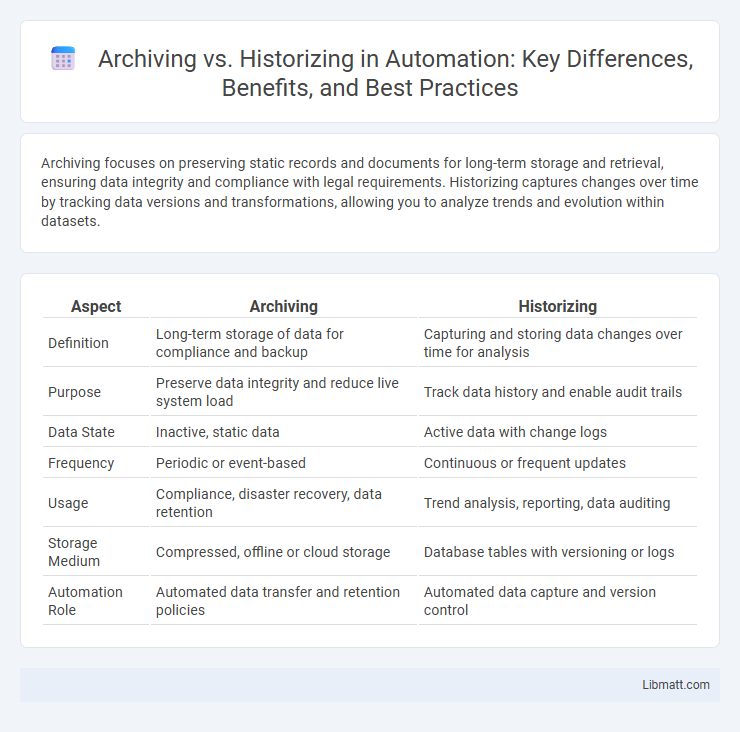Archiving focuses on preserving static records and documents for long-term storage and retrieval, ensuring data integrity and compliance with legal requirements. Historizing captures changes over time by tracking data versions and transformations, allowing you to analyze trends and evolution within datasets.
Table of Comparison
| Aspect | Archiving | Historizing |
|---|---|---|
| Definition | Long-term storage of data for compliance and backup | Capturing and storing data changes over time for analysis |
| Purpose | Preserve data integrity and reduce live system load | Track data history and enable audit trails |
| Data State | Inactive, static data | Active data with change logs |
| Frequency | Periodic or event-based | Continuous or frequent updates |
| Usage | Compliance, disaster recovery, data retention | Trend analysis, reporting, data auditing |
| Storage Medium | Compressed, offline or cloud storage | Database tables with versioning or logs |
| Automation Role | Automated data transfer and retention policies | Automated data capture and version control |
Understanding Archiving: Definition and Purpose
Archiving involves the systematic storage of data or documents for long-term preservation and future reference, ensuring that important information remains accessible and intact over time. Its primary purpose is to protect organizational memory, maintain compliance with legal and regulatory requirements, and support efficient data retrieval when needed. Understanding archiving helps you implement effective data management strategies that safeguard valuable records without cluttering active systems.
What is Historizing? An Overview
Historizing refers to the process of systematically recording and storing changes in data over time to maintain a complete history of its evolution. Unlike archiving, which typically involves moving inactive or outdated data to long-term storage, historizing ensures that all modifications, including timestamps and versioning, remain accessible for audit, analysis, or compliance purposes. Your data management strategy benefits from historizing by enabling detailed tracking of data changes without losing context or access to past states.
Key Differences Between Archiving and Historizing
Archiving involves storing data that is no longer actively used but retained for long-term preservation and compliance, while historizing captures changes over time to provide a detailed record of data evolution for analysis or auditing. Archiving typically results in static, compressed files stored in separate systems, whereas historizing maintains dynamic, time-stamped records within the primary database or data warehouse. Your choice between archiving and historizing depends on whether you need to preserve data snapshots for regulatory purposes or track granular historical changes for business intelligence.
Use Cases: When to Archive vs When to Historize
Archiving is ideal for long-term storage of inactive data that must be preserved for regulatory compliance or legal purposes, such as financial records or tax documents. Historizing suits scenarios requiring the tracking of data changes over time for analysis or auditing, like monitoring customer order status or inventory levels. Choose archiving when data access is infrequent but retention is mandatory, and historizing when capturing data evolution is essential for business insights or operational accuracy.
Data Retention Policies: Archiving and Historizing
Data retention policies differ significantly between archiving and historizing, with archiving focusing on long-term storage of inactive data that must be securely preserved for compliance and legal requirements. Historizing captures changes over time within active datasets, enabling you to track data evolution without permanently removing any information. Implementing clear retention rules ensures data integrity and accessibility aligned with organizational governance and operational needs.
Storage Solutions and Technologies for Archiving vs Historizing
Archiving typically relies on long-term storage solutions such as tape libraries, cloud cold storage, and WORM (Write Once Read Many) drives designed for data immutability and compliance retention policies. Historizing uses time-series databases, data lakes, and high-performance storage systems that enable efficient retrieval and analysis of rapidly changing data over time. Both approaches leverage advanced storage technologies, but archiving prioritizes durability and low-cost storage, while historizing emphasizes speed and accessibility for temporal data queries.
Legal and Compliance Aspects
Archiving ensures the long-term preservation of records to meet legal retention requirements and regulatory compliance, preventing data tampering and loss. Historizing captures and stores changes over time within systems, providing an audit trail essential for compliance audits and forensic investigations. Your organization must balance these approaches to satisfy legal obligations and maintain accurate historical data for accountability.
Performance Impact on Systems
Archiving reduces system load by moving inactive data to separate storage, improving database performance and query speed for active datasets. Historizing maintains detailed historical records within the system, which can increase data volume and potentially slow down real-time processing and analytics. Your choice between archiving and historizing depends on balancing performance needs with the necessity for detailed historical insights.
Best Practices for Effective Data Management
Archiving involves storing data that is no longer actively used but must be retained for compliance or future reference, while historizing tracks changes in data over time to preserve a complete record of its evolution. Best practices for effective data management include implementing clear retention policies, using metadata to enhance searchability, and selecting appropriate storage solutions that balance accessibility with security. Leveraging automated tools for both archiving and historizing ensures data integrity and supports efficient retrieval when needed.
Future Trends in Archiving and Historizing
Future trends in archiving emphasize automation, AI-driven metadata tagging, and enhanced digital preservation techniques to ensure seamless access and long-term data integrity. Historizing increasingly integrates real-time data analytics and blockchain technology to provide immutable, transparent records for compliance and audit purposes. Your organization can leverage these advancements to optimize data management strategies and future-proof information retrieval.
Archiving vs Historizing Infographic

 libmatt.com
libmatt.com